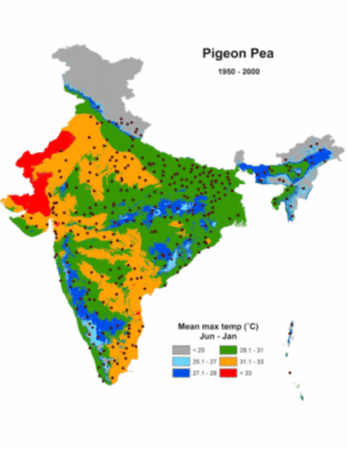- Broadening the Base, Narrowing the Task: Prioritizing Crop Wild Relative Taxa for Conservation Action. Use socioeconomic value of crop, and potential usefulness and threat status of relative.
- Germinate 3: Development of a Common Platform to Support the Distribution of Experimental Data on Crop Wild Relatives. Useful in determining the second of the above.
- Re-defining the yam (Dioscorea spp.) core collection using morphological traits. Cleaning up the core.
- “Things are different now”: Farmer perceptions of cultural ecosystem services of traditional rice landscapes in Vietnam and the Philippines. 73 indicators for the contribution of landscapes to culture, aesthetics, and local knowledge.
- A single-nucleotide polymorphism causes smaller grain size and loss of seed shattering during African rice domestication. You want no shattering? You also get smaller seeds. Like it or edit it.
- Digital conservation: An introduction. Brave new world… Special issue of Ambio.
- The Genomic History Of Southeastern Europe. Souther Greek Neolithic farmers not same as other European Neolithic farmers.
- Genomics of a revived breed: Case study of the Belgian campine cattle. Racial impurities are confined to a few farms.
- Reducing emissions from agriculture to meet the 2 °C target. We’re doomed.
- Conservation of biodiversity as a strategy for improving human health and well-being. By keeping animals and their nasty diseases away from people, we’re not talking communing with Nature here.
- The interaction of human population, food production, and biodiversity protection. Minimise the interaction.
- Nature’s pulse power: legumes, food security and climate change. Special issue of Journal of Experimental Botany on legumes. Eat up your beans!
Crop wild relatives on Costing the Earth on the BBC
Botanist James Wong investigates the links between global warming and the rate at which crops are able to adapt and evolve to rapidly changing conditions.
That includes how crop wild relatives can help.
The money quote:
The first rule of intelligent tinkering is you don’t throw away any of the parts just because you’re not sure what they’re for.
Brainfood: CWR use, Mainstreaming, Duplicates, Phaseolus model, Cherimoya diversity, Legume mixtures, ICRISAT pearl millet, Taste breeding, Rhubarb rhubarb, Plasticity, Seed dispersal
- The Use of Crop Wild Relatives in Maize and Sunflower Breeding. In maize, unlike sunflower, it just hasn’t been worth it. Yet.
- Securing sustainable and nutritious food systems through mainstreaming agricultural biodiversity: an interdisciplinary study. What works in Brazil won’t necessarily fly in India.
- Duplication assessments in Brassica vegetable accessions. Half of 13 accession pairs/triplets with identical names from VIR and NordGen turned out to be morphologically identical.
- Beans (Phaseolus ssp.) as a Model for Understanding Crop Evolution. 7 independent domestication “events” spread across 5 species and 2 continents makes for some interesting natural experiments.
- A Mesoamerican origin of cherimoya (Annona cherimola Mill.). Implications for the conservation of plant genetic resources. Compare and contrast with above.
- Highly productive forage legume stands show no positive biodiversity effect on yield and N2-fixation. Sometimes diversity doesn’t add much.
- Genetic Resources of Pearl Millet: Status and Utilization. 22,888 accessions from 51 countries. Indian landraces: earliness, high tillering, high harvest index and local adaptation; African: bigger panicles, large seed size, and disease resistance.
- Use of natural diversity and biotechnology to increase the quality and nutritional content of tomato and grape. Both are needed.
- Rhubarb (Rheum species): the role of Edinburgh in its cultivation and development. From China, via Russia, with love.
- Will phenotypic plasticity affecting flowering phenology keep pace with climate change? If the change is smaller than about 13 days.
- Seed dispersers help plants to escape global warming. Because they move seed >35 m per decade uphill.
Nibbles: Rice in Trinidad, Sweet potatoes in Ethiopia, EU crop diversity double, Sir Peter on the ginkgo, Forages, Brazilian peanuts, Seed moisture, Phenotyping double, Svalbard deposit, CATIE data, Herbarium double, Seed #resistance, Father of the apple, Agave congress
- African rice out of Africa, and out of the genebank.
- The other way around for sweet potato.
- Markers for micronutrients. And diversity for taste…
- The deep history of the ginkgo.
- Study plants to decrease the effects of burping.
- Brazil rationalizes peanut collections.
- Measuring moisture in seeds.
- Big data for better seeds. And not only in Iowa.
- NZ seeds in Svalbard.
- CATIE on Genesys.
- Oz biosecurity fail. Better stick to online.
- I want to be a seed rebel too.
- Maybe in Kazakhstan?
- Agave under the volcano under the cosh.
An Indian pigeonpea GIF for the ages
Thanks to GIFmaker for allowing me to produce a, well, GIF, out of those maps of the distribution of India’s pigeonpea collection that I put up yesterday. I think you’ll need to click on it to get the full benefit.
Look at those swathes of green becoming orange, i.e. going up 2 degrees in mean maximum temperature during June-January. Will pigeonpea be able to adapt in situ? Or will there have to be a transfer of material from the currently orange areas? And what to do about the areas becoming red? Not much pigeonpea in the currently red areas…
